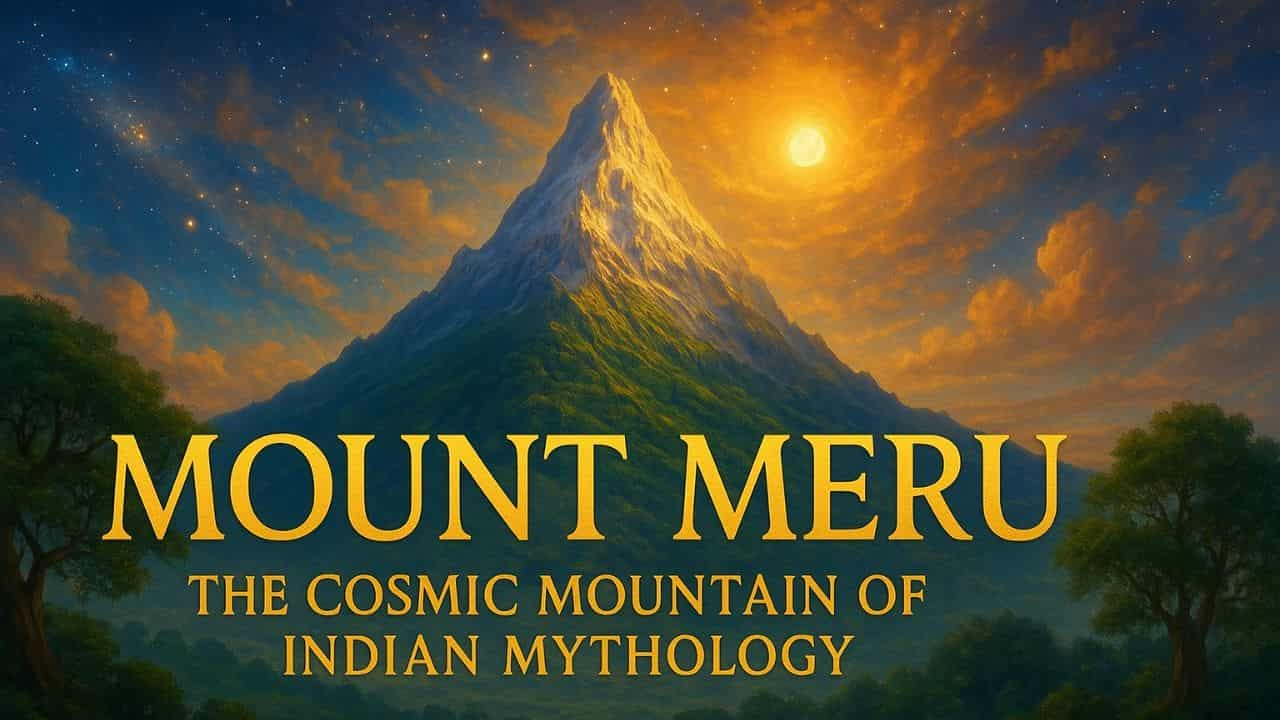
Mount Meru: A Sacred Axis of the Universe
In the vast tapestry of Indian mythology, Mount Meru holds a place unlike any other. Known as the cosmic mountain, it is believed to be the axis around which the entire universe revolves.
For centuries, sages, poets, and temple builders have drawn inspiration from Meru, embedding its imagery in scripture, architecture, and ritual. Unlike gods and heroes who exist within time and space, Mount Meru stands apart. It represents stability itself, a metaphysical center that bridges heaven and earth.
Today, Mount Meru is more than a mythological concept. It has become a metaphor for balance, reflecting humanity’s constant search for harmony in a shifting world. In many ways, it symbolizes the equilibrium that modern life often overlooks.
By exploring Meru’s mythological roots, symbolic meanings, and cultural echoes, we discover why this ancient cosmic mountain continues to inspire. Even now, it remains a timeless reminder of stability, harmony, and connection between the earthly and the divine.
Meru in the Puranas and Epics
Mount Meru is described in detail in several Puranas, such as the Vishnu Purana and the Bhagavata Purana. It is said to rise 84,000 yojanas high, glittering with gold, silver, and jewels. The gods reside on its summit, while rivers flow from its sides to nourish the earth.
The Mahabharata also refers to Meru as a divine mountain surrounded by seas and smaller peaks. Indra’s city, Amaravati, is believed to be on Meru, making it the seat of heavenly governance. This mountain is not merely a location but a cosmic design, a template of order in the universe.
Symbol of Cosmic Order
Meru is frequently referred to as the “axis mundi,” or the globe’s axis of motion. Just as an axis allows a wheel to turn, Meru is seen as the spiritual center that allows the cosmos to exist in balance. Its solidity reflects the grounding that all beings seek in life, and its vertical form symbolizes the journey from the earthly to the spiritual.
In Hindu cosmology, Meru is surrounded by seven concentric seas and mountains, representing layers of existence. This structured imagery speaks to the importance of order in a universe that otherwise appears chaotic. It is a reminder that balance is not accidental but carefully sustained.
Meru and the Churning of the Ocean
One of the most famous myths involving Mount Meru is the Samudra Manthan, or the churning of the cosmic ocean. To extract amrita (the nectar of immortality), gods and demons used Mount Mandara as a churning rod and the serpent Vasuki as a rope. But some traditions suggest that Mandara itself was part of Meru.
This story underlines the mountain’s symbolic role as a stabilizer. Without a steady axis, the churning would collapse. Similarly, in human life, without stability in values and discipline, no great endeavor can succeed.
Meru in Temple Architecture
Indian temples often reflect Meru in their design. The towering shikhara of North Indian temples and the vimana of South Indian temples are architectural echoes of Meru. These rising forms symbolize the cosmic mountain, guiding the devotee’s gaze upward toward the heavens.
At Angkor Wat in Cambodia, a masterpiece of Hindu-Buddhist architecture, the central tower is modeled after Mount Meru, surrounded by smaller towers and moats that represent the seas and mountains encircling it. Every devotee walking into these temples is symbolically climbing Meru, journeying from the material to the divine.
Buddhist and Jain Perspectives
Meru is not exclusive to Hinduism. In Buddhist cosmology, Mount Meru is central, surrounded by four continents and multiple heavens. The gods of the Trayastrimsha heaven, ruled by Indra, dwell on its summit.
In Jain traditions, Meru is also seen as the center of the middle world, around which celestial beings, rivers, and continents are arranged. Pilgrimage sites such as Shatrunjaya and Sammed Shikhar are metaphorically linked to Meru, emphasizing the mountain as a symbol of liberation.
This cross-traditional presence highlights Meru’s universality. It is not just a Hindu mountain but a pan-Indic symbol of cosmic harmony.
Meru as a Metaphor for the Mind
Beyond cosmology, Meru can be read as a metaphor for the human mind. Just as Meru stands firm amidst swirling seas and forces, the mind too must remain steady amid distractions and challenges.
Meditation in Indian traditions is often likened to climbing a mountain, step by step, toward clarity and higher awareness.
The mountain’s summit symbolizes enlightenment, while its base represents ordinary life. The ascent is not physical but spiritual, requiring discipline, focus, and resilience.
Environmental Echoes of Meru
Though mythological, Meru’s imagery has an ecological resonance. Rivers flowing from its sides represent nourishment, reminding humanity of nature’s generosity. In today’s context of environmental crisis, Meru can be seen as a call to honor the natural balance that sustains life.
When rivers are polluted and mountains are stripped of forests, the “cosmic order” symbolized by Meru feels disrupted. By treating Meru as a metaphor for ecological balance, mythology inspires sustainable living.
Lessons of Stability and Balance
The mythology of Meru conveys several enduring lessons:
- Seek balance: Just as Meru balances heaven and earth, individuals must balance ambition with humility, duty with desire.
- Find a center: In an age of distraction, having a personal “axis” , values or practices that ground us , is essential.
- Climb steadily: Spiritual or personal growth is like ascending Meru; it requires patience and effort.
- Respect order: The layered cosmos around Meru symbolizes the importance of respecting systems, whether social, ecological, or spiritual.
Meru in Modern Imagination
Mount Meru continues to inspire beyond scriptures. Writers and filmmakers often use it as a symbol of mystery and transcendence.
In yoga philosophy, the spine is sometimes likened to Meru, with chakras as steps toward the summit of consciousness.
In everyday life, people unknowingly recreate Meru when they decorate homes with pyramids or worship at towering temple shikharas. The idea of a central, grounding force resonates across cultures, even outside India.
Mount Meru: A Mountain Beyond Time
Mount Meru is not just a mythic peak hidden in scripture; it is a living symbol. It represents order amid chaos, ascent amid struggle, and stability amid change. By imagining a cosmic mountain at the universe’s heart, ancient thinkers offered a way to understand life itself: grounded, layered, and striving upward.
For modern readers, Meru’s lesson is clear. Find your axis, climb steadily, and live in balance with the larger order around you. Like the cosmic mountain, resilience and harmony can make us stand tall even when the seas of life churn endlessly around us.

